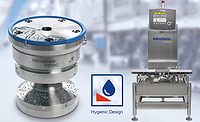Level measurement
Level measurement technology that is better by design
Accurate and reliable continuous level measurement is essential in food and beverage production

The level measurement instrumentation used in food and beverage production must fulfill certain vital criteria. First and foremost, it must accurately and reliably measure the level of the material contained in the various storage, holding and buffer tanks utilized in manufacturing facilities. Precise level measurements help to ensure consistent product quality, increase safety by protecting against both overfills and dry-running pumps, prevent product loss, and optimize inventory management and stock availability. It is also important that level measurement devices should be as easy as possible to install and integrate into an automation system, as this reduces complexity for manufacturers. Of course, any instrumentation used in food and beverage manufacture also needs to comply with the industry’s strict hygiene and food safety standards, to prevent products from being contaminated during the production processes.
Technology selection
A broad range of technologies can be used to provide either continuous level measurement or point-level detection in modern food and beverage production. These can include guided wave radar transmitters, pressure transmitters, ultrasonic transmitters, load cells, capacitance switches and vibrating fork level switches. However, it is non-contacting radar transmitters that best meet the industry’s requirement for measurement accuracy and hygienic components, while providing users with a wide range of further benefits. These devices are top-mounted, which reduces the risk of leakage, and their measurement accuracy is unaffected by process conditions such as density, viscosity, conductivity, coating, corrosiveness, vapors, and changing pressure and temperature. In addition, because they provide continuous level measurements without touching the material surface, this results in low maintenance requirements and helps ensure long-term reliability.
Non-contacting radar transmitters have traditionally been used in the very large tanks or vessels typically found in the oil, gas and petrochemical industry, to accurately monitor levels in safety-critical applications. These devices have also been applied in food and beverage production facilities, but are often considered to be too costly, large and bulky, and some do not have a full range of hygienic approvals and process connections. However, the latest non-contacting radar level sensors, which use single chip technology rather than a separate circuit board, have been designed specifically for continuous level measurement in hygienic applications found in the food and beverage industry. These compact and cost-effective devices provide manufacturers with many significant benefits.
Increased accuracy
Radar transmitters rely on reflected signals, or echoes, to perform level measurement. The latest level sensors use fast sweep technology to provide a continuous echo against the surface that delivers a more robust and reliable measurement, even in challenging fast-filling vessels. This enables these devices to collect up to 40 times more information than legacy transmitters. This increases their measurement accuracy and enables manufacturers to reduce the amount of product lost through wastage, maximize production capability, and reduce production variations, leading to increased product quality and batch consistency.
Compact design
An area of improvement in the development of non-contacting radar devices has been a reduction in footprint. In oil and gas applications, there are unlikely to be demands placed on level measurement instrumentation in terms of space, but the skids typically used in the food and beverage industry have very tight piping arrangements, making it difficult to install large or bulky devices. The latest non-contacting radar level sensors use 80 GHz frequency modulated continuous wave technology on a single electronic chip with embedded smart algorithms. This enables exceptional radar beam focusing, so that internal tank obstructions such as agitators can be avoided, and greater measurement accuracy achieved even when tanks contain objects inside. It also enables devices to be much more compact and therefore an ideal solution for the small tanks often used in food and beverage production. In addition, the use of smaller devices with fewer electronics results in positive effects for the environment.
Maximize production
It is important for food and beverage manufacturers to ensure they are maximizing production capacity to increase revenue, lower their costs and ensure they can keep up with customer demands. The latest radar technology enables level sensors to perform accurate measurements all the way up to the top of the tank, with no dead zone. Eliminating dead zones makes the best use of the tank while also ensuring the vessel is not overfilled, thereby helping to maximize production capacity and reduce both product loss and costs.
Food safety
Food and beverage manufacturers must take all the precautions they can to reduce the risk of contamination in their processes. The latest level sensors have been designed so that their performance in unaffected during tank clean-in-place (CIP) and sterilize-in-place (SIP) processes. These sensors have a hygienic antenna that is flush with the process connection and insensitive to condensation and build-up, ensuring the removal of process residue during CIP and SIP, and their broad range of hygienic process connections fit most common tank connections and sizes. On top of running tank cleaning processes, many facilities will wash down the outside of their tanks with foaming chemicals and/or high pressure and high temperature water to maintain their high sanitary standards. The latest level sensors feature polished stainless steel housings with minimal crevices, which allows water and any sediments to drain from their body, thereby reducing the risk of bacteria growth. These devices are also IP69-rated, which allows them to withstand high pressure and high temperature washdowns. They have a full range of hygienic approvals, ensuring they will meet the food safety standards of any facility.
Ease of integration
Reducing complexity is an important aim for food and beverage manufacturers, and it is important for instrumentation to be easy to integrate with any automation system. For example, the Rosemount 1408H level sensor is the first non-contacting radar transmitter with connectivity to the IO-Link communication protocol, making it easy to integrate with any automation system. The transmitter provides conventional 4-20 milliamperes, switch outputs and digital high-speed communication. Software configuration tools allow the device to be connected and configured online or offline, with easy-to-use graphic interfaces decreasing commissioning time, optimizing device replacement processes, and digitally recording parameter settings.
Conclusion
The latest non-contacting radar technology advancements, combined with connectivity to the IO-Link communication protocol, will help food and beverage manufacturers to reduce production variations for increased product quality and batch consistency. Improved measurement accuracy and reliability will also help to minimize product loss and, through greater tank utilization, help to increase production efficiency and throughput.
To learn more, visit Emerson.com/Rosemount1408H.
Felix Johansson is a solutions engineer for Emerson’s radar level business. Felix holds a Master of Science degree in industrial engineering and management, with a major in quality technology and management, plus a Bachelor of Science degree in business administration, both from Luleå University of Technology in Sweden. His current role focuses on Emerson’s level measurement offering for the food and beverage and life science industries. He has been with Emerson since 2017 and his previous roles include product management work within industrial automation.
Looking for a reprint of this article?
From high-res PDFs to custom plaques, order your copy today!






